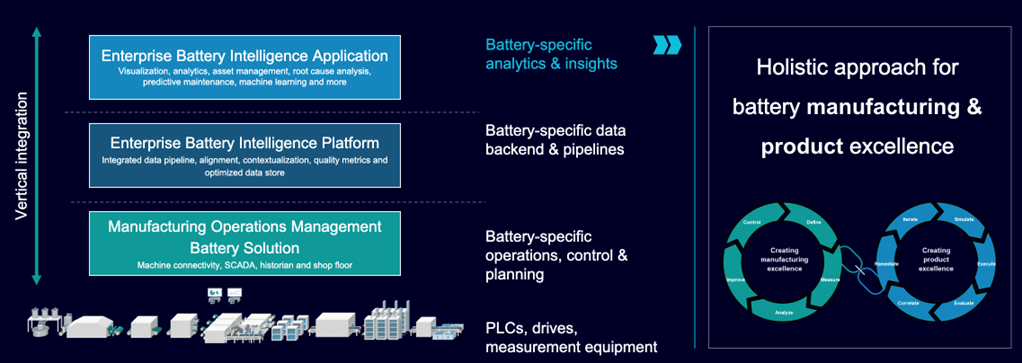The world is relying on battery-powered products more than ever, from the largest vehicles to the smallest personal devices. Experts are forecasting a 14-fold increase in battery demand between 2018 and 2030 and a five-fold growth in battery cell production from 2020 to 2030 for EVs alone. The increased demand for battery manufacturing introduces numerous challenges and different complexities to manage, including quality control, production efficiency, waste reduction and cost minimization.
Siemens Digital Industries Software and Voltaiq have developed a new solution that combines Insights Hub and Enterprise Battery Intelligence™ (EBI) to accelerate battery manufacturing. Through this collaboration, which brings together the production-proven capabilities of both companies, battery-domain customers can gain access to unparalleled capabilities to help rapidly scale operations smoothly, from initial testing to full-scale production lines.
Siemens and Voltaiq confront battery manufacturing challenges head-on with combined solution
This collaboration aims to tackle battery manufacturing’s key challenges.
- Quality control and consistency: Consistently ensuring each battery meets the highest standards for performance and safety is challenging. Variations in manufacturing conditions can lead to inconsistencies in battery quality, so it’s important to maintain rigorous quality control throughout production. To stay competitive, manufacturers must accelerate material and design innovations and optimize battery costs while reaching energy density targets and ensuring safe battery utilization.
- Increasing production: Scaling up battery production to meet increasing demand, especially for electric vehicles, without compromising quality or efficiency is a significant challenge. This includes managing larger automated giga facilities at scale with consistent machine performance, while understanding – and reacting to – the influences of complex machinery to the characteristics of battery cells.
- Process efficiency and waste reduction: Battery manufacturing involves complex chemical processes – a combination of batch process, continuous process and discrete process – that is complex to manage. Manufacturers strive to optimize these processes to minimize waste and improve overall efficiency, addressing both cost and environmental concerns.
- High costs: Manufacturers must find ways to constantly reduce costs without compromising product quality. These include the cost of raw materials, manufacturing processes, and technology development.
Siemens’ Insights Hub proven industrial IoT solutions combined with Voltaiq’s comprehensive suite of battery-specific monitoring, visualization, and advanced analytics capabilities provides customers with a seamless end-to-end solution for managing and optimizing battery cell manufacturing.
The joint solution addresses the challenges faced in the critical finishing stage of battery production – which makes up a significant portion of the production costs and time – by helping to reduce the risk associated with discovering problems late in the production cycle where yield and profitability are most likely to decrease.

The Voltaiq solution enables manufacturers to leverage Insights Hub closed-loop analytics, combined with signals in electrochemical and manufacturing data, to spot battery problems in real-time so they can correct upstream issues earlier in the process, improving battery quality and yield, while helping to accelerate scale-up. With faster time to data-driven battery insights, customers realize immediate, measurable and durable ROI for battery programs.

Our collaboration with Voltaiq aligns with Siemens’ ongoing mission to continue delivering industrial IoT solutions with immediate business value. By integrating our efforts, we not only help to enhance operational decision making but also assist our customers to accelerate the digital transformation of organizations, contributing to a new era in battery manufacturing.
Raymond Kok, SVP and Managing Director, Cloud and Edge Foundational Services, Siemens Digital Industries CTO
The battery industry is struggling to scale and needs to improve quality and decrease scrap rates rapidly in order to stay competitive. By joining forces with Siemens, we’re able to deliver a complete solution to help accelerate toward an electrified future.
Tal Sholklapper, CEO and co-founder, Voltaiq
Experience the holistic solution for optimizing battery cell manufacturing
Here are just a few use cases and benefits that manufacturers can realize:
- Closed-loop factory digital twin: Inject real data into equipment/factory models to identify root causes and solutions to help reduce scrap rate with faster iteration thanks to earlier detection and remediation of issues on the factory floor.
- Closed-loop product digital twin: Reduction of product quality issues thanks to speedier detection and remediation of issues during end-of-line formation, aging, and product quality assurance (QA) processes.
- Production visibility and experimental analysis: Evaluate production performance with trusted and automated descriptive analytics of production status. Enable rapid product development with a real-time feedback loop between testing and simulation. Increase uptime and reduce scrap with predictive analytics for equipment maintenance and production quality.
- Real-time battery behavior: Achieve on-time launch by detecting issues early thanks to electrochemical analytics, rapid simulations and improving designs.
Voltaiq’s technology can identify cell anomalies early in the first formation cycle – days or weeks before many cell anomalies are typically detected through traditional QA. Voltaiq’s EBI solution is comparable with existing formation cycling equipment so no complex implementation is needed, and value can be realized in less than one month. As the “glue” that connects battery-domain enterprise tools, EBI is a pioneer in battery-focused analytics platforms.

With the strategic collaboration between Siemens and Voltaiq, the future of battery manufacturing looks brighter, more efficient, and more sustainable, as manufacturers can be ready to meet the demands of the increasing battery-reliant world.

